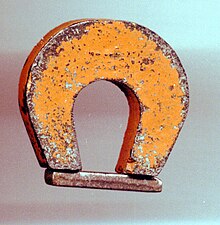
Back ألنيكو Arabic Alnico Catalan Alnico Danish Alnico German Alnico Spanish آلنیکو Persian Alnico Finnish Aimant AlNiCo French Alnico Galician Alnico Croatian

Alnico is a family of iron alloys which, in addition to iron are composed primarily of aluminium (Al), nickel (Ni), and cobalt (Co), hence the acronym[1] al-ni-co. They also include copper, and sometimes titanium. Alnico alloys are ferromagnetic, and are used to make permanent magnets. Before the development of rare-earth magnets in the 1970s, they were the strongest permanent magnet type. Other trade names for alloys in this family are: Alni, Alcomax, Hycomax, Columax, and Ticonal.[2]
The composition of alnico alloys is typically 8–12% Al, 15–26% Ni, 5–24% Co, up to 6% Cu, up to 1% Ti, and the rest is Fe. The development of alnico began in 1931, when T. Mishima in Japan discovered that an alloy of iron, nickel, and aluminum had a coercivity of 400 oersteds (32 kA/m), double that of the best magnet steels of the time.[3]
- ^ Hellweg, Paul (1986). The Insomniac's Dictionary. Facts On File Publications. p. 115. ISBN 978-0-8160-1364-7.
- ^ Brady, George Stuart; Clauser, Henry R.; Vaccari, John A. (2002). Materials Handbook: An Encyclopedia for Managers. McGraw-Hill Professional. p. 577. ISBN 978-0-07-136076-0.
- ^ Cullity, B. D.; Graham, C. D. (2008). Introduction to Magnetic Materials. Wiley-IEEE. p. 485. ISBN 978-0-471-47741-9.
© MMXXIII Rich X Search. We shall prevail. All rights reserved. Rich X Search